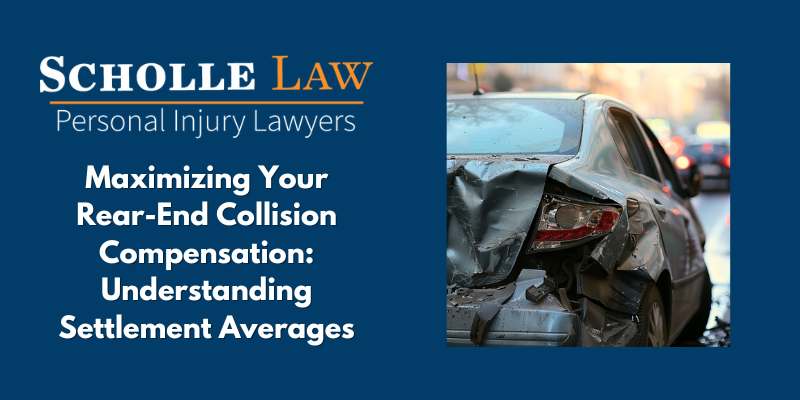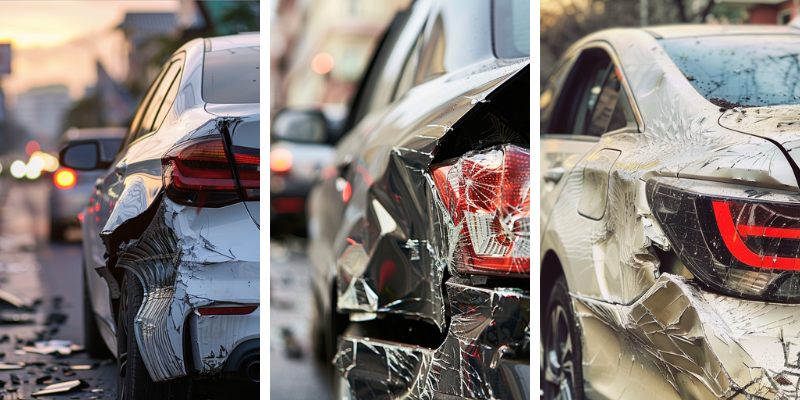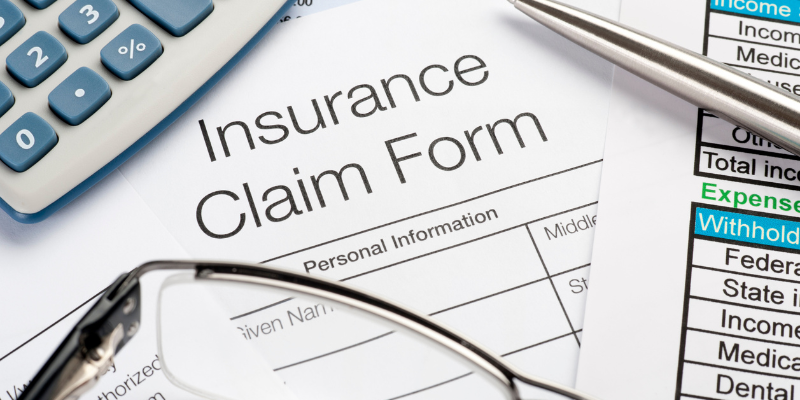4.9 Rating
Google REVIEWS
Leaders in Georgia Personal Injury Law Since 1995
Maximizing Your Rear-End Collision Compensation: Understanding Settlement Averages
Have you been hit from behind and left wondering what compensation you’re entitled to? Look no further. Scholle Law dives straight into the heart of rear-end collision compensation, explaining the factors that determine your settlement and how to fight for what you’re owed. Whether it’s medical expenses or lost wages, we outline the steps to ensure you’re not short-changed for the ordeal you’ve endured.

Key Takeaways
- Rear-end collision compensation is based on several factors including medical expenses, lost wages, and pain and suffering; it’s critical to account for long-term impacts like ongoing treatment and loss of earning capacity when seeking settlements.
- Establishing fault is complex in rear-end collision cases and can involve multiple forms of evidence; understanding local negligence laws and negotiating with insurance companies can significantly affect settlement outcomes.
- Personal injury attorneys Scholle Law play a vital role in maximizing compensation for rear-end collision victims through strategic negotiation, comprehensive evidence collection, and readiness to litigate if necessary.

Understanding Rear End Collision Compensation
There are a lot of costs associated with car accidents, particularly a rear-end collision: the medical bills stacking up, days or even months of lost wages, and the less tangible, yet equally important, pain and suffering. These are the pillars of a rear-end accident settlement. Recognize that each car accident case bears its unique characteristics, much like the individuals involved, including the car accident victim. Evidence like medical records and imaging scans not only substantiate the physical toll but also highlight the financial burden incurred.
Delay medical treatment, and you might be giving the opposition an opportunity to question the causation of your injuries. Hence, factoring in long-term costs like ongoing treatment and loss of earning capacity is paramount in securing a settlement that truly covers your ordeal.
The Determinants of a Fair Rear End Accident Settlement
Rear-end collision accident cases can be likened to puzzles, with elements such as:
- medical bills
- lost wages
- pain and suffering coming together to form a picture of fair compensation. In a rear end accident case, the severity of the injuries, the disruption to daily life, and property damage all play pivotal roles in determining what is rightly owed to you after being rear ended.
When a rear-end collision leaves a long-term scar, be it physical or financial, like a loss of income or potential career setbacks, it magnifies the need for a settlement that truly addresses the gravity of the situation.

Severity of Injuries and Medical Costs
The heart of your claim lies in the severity of your injuries. Severe injuries that can result from rear-end accidents include:
- Back injuries
- Soft tissue damage
- Chronic pain
- Joint dysfunction
These injuries can lead to substantial settlements due to the cost of medical treatment and lengthy recovery periods. Medical expenses can further increase if surgeries, medication, and long-term rehabilitation are necessary.
Insurance companies, fully cognizant of this, often assign more value to claims when injuries necessitate extended treatment durations and intensify pain and suffering, a factor that is ultimately reflected in the offered compensation by the insurance company.
Establishing Fault in a Rear End Car Accident
Both in the legal realm and the court of public opinion, determining who is at fault is of utmost importance. In rear-end collisions, the driver at the back often bears the burden of fault, particularly in jurisdictions like Georgia where they are responsible for compensating the victim. However, fault is not always so straightforward. Factors like poor road conditions, sudden stops, or even a vehicle’s faulty brake lights can redistribute the blame.
Evidence, ranging from:
- police reports
- witness statements
- videos
- accident reconstruction reports
is critical in establishing negligence. Moreover, the nuances of laws like contributory and comparative negligence can alter the fault determination, allowing for partial compensation even when the victim shares some of the blame. But remember, these rules vary by state, underscoring the importance of your lawyer understanding local laws to ensure a fair settlement.
Insurance Policy Limits and Negotiation
When discussing settlements, one must consider not only the numbers but also the caps set by insurance policy limits. These limits set the stage for the maximum payouts an insurer will provide, potentially capping the available compensation in a rear-end accident settlement. Navigating policy limits requires a deep dive into the at-fault party’s primary liability policy and any excess insurance that could sweeten the pot. It’s important to keep in mind the average settlement when evaluating these factors.
In cases where the damages soar above the at-fault party’s insurance coverage, tapping into other policies or even personal assets may be necessary to fill the gap. Negotiating with insurance companies is an art, and strategies like your personal injury lawyer at Scholle Law submitting a policy limits demand letter can be instrumental in asserting full compensation based on documented losses.

Calculating Non-Economic Damages in Rear End Accidents
Quantifying non-economic damages, such as pain and suffering, is challenging due to the absence of a clear price tag or receipt. These damages are deeply personal and inherently subjective, making them challenging to quantify. The multiplier method offers a formulaic approach, multiplying total medical bills by a factor that reflects the pain and suffering endured, while the per diem method assigns a daily rate to the victim’s experience. Factors such as the severity of the accident, the long-term impact of injuries, and the emotional toll they take are all part of the equation. Supporting evidence, like a letter from a mental health counselor, can be pivotal in painting a picture of the psychological aftermath and bolstering claims for non-economic damages.
Legal Representation: Partnering with a Personal Injury Lawyer
Venturing into a rear-end collision case without the guidance of a seasoned personal injury lawyer is like navigating a storm without a compass. The legal professionals at Scholle Law are the navigators who can chart the course to a fair settlement, ensuring that every damage, be it physical, emotional, or financial, is accounted for.
Scholle Law Car & Truck Accident Attorneys, with our track record of success, bring a wealth of experience that can dramatically influence the outcome of your compensation claim.

The Role of a Personal Injury Attorney in Maximizing Compensation
A personal injury attorney at Scholle Law is not just your advocate; we are your strategist and defender in the battle for just compensation. With our effective negotiation techniques and readiness to take a case to court if necessary, we ensure that victims receive the maximum possible settlement. We provide the following services:
- Build robust cases with comprehensive investigations
- Obtain crucial evidence
- Handle all interactions with insurance companies, shielding clients from tactics that could undermine their claims
Should an insurance provider refuse to settle within policy limits unreasonably, an attorney can pursue bad faith claims, providing a safety net for clients with losses that go beyond those limits.
Why a Free Consultation With A Car Accident Lawyer Can Be a Game-Changer
A free consultation with our personal injury legal staff, following a rear-end collision can pave the way towards understanding and recovery. It’s an opportunity to discuss the details of your accident, understand your potential for compensation, and learn about your legal rights, all without any financial commitment. This no-risk consultation enables you to assess our lawyer’s experience, understanding and strategy, ensuring that you are comfortable and confident in our ability to represent your interests effectively.

What to Do Immediately After a Rear End Collision
Prompt, appropriate actions following a rear-end collision are critical to safeguarding your legal rights and documenting the incident accurately. This is where the knowledge of a personal injury lawyer becomes invaluable, guiding you through the necessary actions from preserving evidence to understanding the statute of limitations.
Before you even set foot in our law firms office for your free consultation, make sure you have all your important documents in hand and questions at the ready to make the most of the opportunity.
Gathering Evidence at the Scene
The moments immediately following a rear-end collision are your window of opportunity to gather evidence that can be vital to your claim. Collecting eyewitness accounts, snapping photographs, and securing any available video footage can make all the difference in substantiating your case.
When you eventually sit down with your attorney, bringing along a police report and any on-scene photos you’ve managed to take will help them assess your case and begin building your claim.
If you don’t have a copy of the police report or don’t know how to locate it, don’t despair. Scholle Law can track that down for you.
Seeking Medical Attention Promptly
Even if you feel fine after a rear-end collision, don’t let the adrenaline fool you. The body has a way of masking pain in stressful situations, which is why seeking medical evaluation as soon as possible is crucial to uncover the full extent of any injuries. Delay in medical treatment not only risks exacerbating any conditions but can also create openings for insurance companies to dispute the severity and causation of your injuries.
Remember, the medical records you create now are not only about your health; they’re a cornerstone of your eventual claim.

Navigating the Insurance Claim Process
Navigating the insurance claim process can feel like traversing a minefield, as insurers employ various tactics, such as recording calls and making low initial offers, to safeguard their interests. While navigating these waters, remember that initial offers are rarely the best ones and that the negotiation process can be a marathon, not a sprint.
Keeping meticulous records, filing claims promptly, and maintaining open lines of communication with your attorney can help expedite the settlement process and ensure that you’re not left adrift.
The Long-Term Impacts of Rear End Collisions
Recovering from a rear-end collision can be a prolonged journey laden with challenges extending well beyond the initial impact. Chronic pain, reduced mobility, and even the emotional scars of PTSD can linger, affecting every aspect of life from personal relationships to work performance. Physical therapy can play a crucial role in addressing these issues and helping individuals regain their quality of life.
When these long-term effects are translated into financial terms, they become pivotal in shaping the compensation you deserve, ensuring that you are not left to shoulder the burden of ongoing medical care and pain management alone.
Summary
As we draw this guide to a close, remember that while the road to compensation after a rear-end collision can be complex, it is not insurmountable. With a clear understanding of the factors that influence settlement amounts, the importance of collecting evidence, and the value of legal experience from Scholle Law, you are now better equipped to navigate the path to fair compensation. Let this knowledge empower you to advocate for the full extent of your losses, ensuring that your recovery is not just a possibility, but a priority.
Frequently Asked Questions
How much to expect from a car accident settlement Georgia?
In Georgia, car accident settlements can range from $15,000 for minor cases to $100,000, with the settlement amount increasing for more severe accidents and injuries. It’s important to note that these figures are not guaranteed and can vary significantly based on the specifics of each case.
Factors such as the extent of the injuries, the impact on the victim’s quality of life, the duration of medical treatment, and the presence of long-term or permanent disability can all influence the final settlement amount. Additionally, the skill of your legal representation and the insurance policies involved also play a critical role in the negotiation process. Therefore, while these ranges provide a rough estimate, the actual settlement can be above or below these figures, reflecting the unique circumstances of the accident and the individuals involved.
What is the rear-end collision law in Georgia?
In Georgia, a driver who rear-ends another car due to tailgating is generally presumed to be at fault for the collision. This presumption is based on the legal expectation that drivers maintain a safe following distance from the vehicle ahead, allowing sufficient time to react and stop to avoid an accident. However, there can be exceptions to this rule if, for instance, the lead car suddenly reverses or has non-functioning brake lights, which could contribute to the accident. Despite these exceptions, the burden typically lies with the tailgating driver to prove that they were not negligent in causing the rear-end collision.
Who is at fault in a rear-end collision in Georgia?
In Georgia, the rear driver is typically deemed at fault in a rear-end collision. However, liability can also be determined based on the degree of fault, and individuals can be held responsible if they are deemed to be over 50% at fault.
Who gets hurt the most in a rear-end collision?
In a rear-end collision, the rear-ended driver typically gets hurt the most due to the impact of the collision. Even a minor collision at slow speeds can cause severe damage.
What types of damages can I claim in a rear-end accident settlement?
In a rear-end accident settlement, you can claim damages for medical expenses, lost wages, and non-economic damages such as pain and suffering. Make sure to gather all relevant documentation to support your claim.
